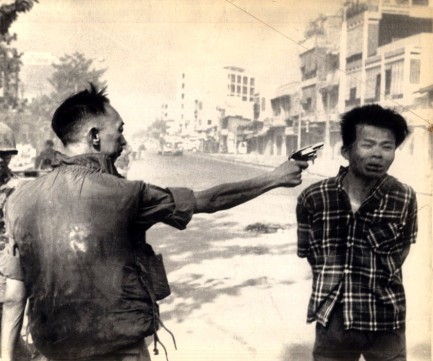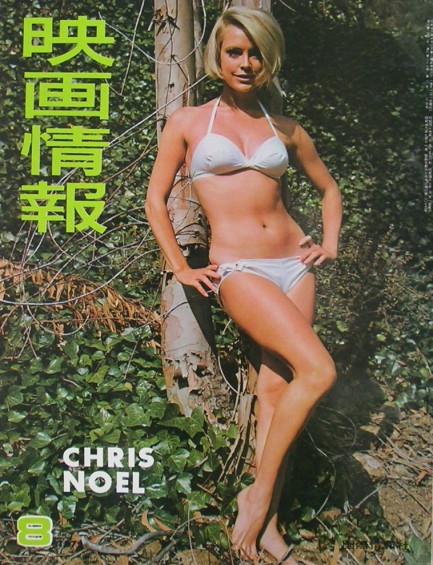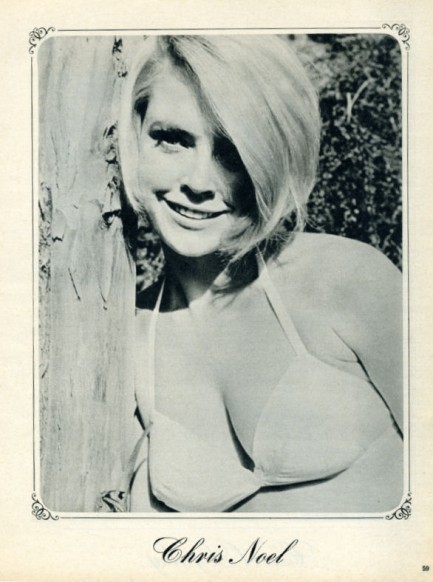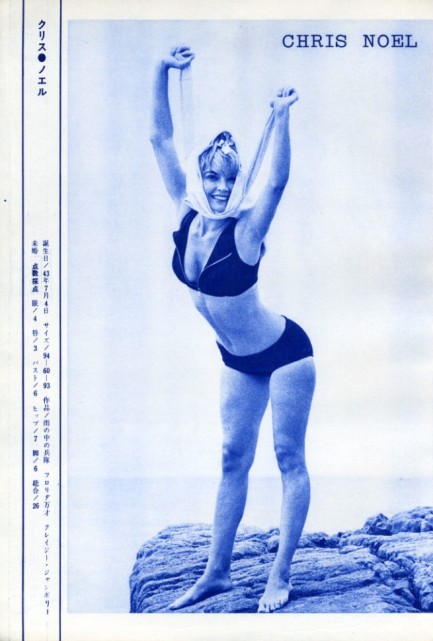 Eddie Adams’ photograph inadvertently helped change public opinion about the Vietnam War. 
Above, one of the most important photographic images of the twentieth century, a Pulitzer Prize winner shot by photographer Eddie Adams. On a sweltering Saigon afternoon, a Viet Cong officer is summarily executed by South Vietnamese national police chief Brig. Gen Nguyen Ngoc Loan, forty-two years ago today. There’s also a widely seen film of the gruesome incident. The photo galvanized the U.S. anti-war effort, but interestingly, Adams regretted taking it, saying that the circumstances around such a photo could never be adequately explained and Nguyen Ngoc Loan appeared to be a villain when perhaps he wasn’t. Such complex considerations are no longer a serious worry for war photographers. Due to Pentagon restrictions, it’s highly unlikely an image like this could now be captured.
 Good thing Chris Noel dressed for warm weather, because she spent quite a bit of time in the jungle. 
We ran across this 1970s-era Japanese celebrity magazine Movie Information featuring Chris Noel on the cover and absolutely had to share it. She was a notable figure during the Vietnam War due to her “A Date with Chris” radio program, which she broadcast twice weekly to American troops. The show was immensely popular. In fact she was thought by the Viet Cong to be such a morale boost that they reportedly placed a $10,000 bounty on her head. They never managed to kill her, but helicopters in which she rode often took ground fire, and two crash-landed with her aboard. Her efforts to make personal contact with U.S. troops were remarkable when you consider she had already established herself in b-movies and on television and may have been on the verge of becoming a star. Yet she put Hollywood on hold and instead became a radio broadcaster in a war zone. After Vietnam she tried to return to movies but the reception in Tinseltown was icy for a minor actress who was perceived to have supported a U.S. war of aggression. Eventually she gave up and opened a shelter for homeless veterans, which she still runs today. All in all it’s a remarkable—perhaps even movie-worthy—story. troops were remarkable when you consider she had already established herself in b-movies and on television and may have been on the verge of becoming a star. Yet she put Hollywood on hold and instead became a radio broadcaster in a war zone. After Vietnam she tried to return to movies but the reception in Tinseltown was icy for a minor actress who was perceived to have supported a U.S. war of aggression. Eventually she gave up and opened a shelter for homeless veterans, which she still runs today. All in all it’s a remarkable—perhaps even movie-worthy—story. History has written a last draft on Vietnam. The event is remembered by the majority of the world as an error, one that cost the U.S. considerable prestige, and resulted in a humanitarian disaster for the Vietnamese—more than two million civilian deaths according to the most conservative tallies. Even the war’s chief architect, Robert McNamara, who died recently, declared the conflict a colossal mistake. Today Vietnam remains under communist rule, but has restored diplomatic ties with the U.S. and is one of the most welcoming nations in the world, a place where American vets comment with amazement upon the Vietnamese ability to put the war behind them despite the ghastly suffering they endured. But whatever history’s take on that divisive period, personalities like Chris Noel are worth admiring. During a time when politicians, pundits, and protestors fought a war of their own over the direction of the United States, Chris Noel rejected the glitz and glamour of Hollywood in order to serve the grunts who were sacrificing their lives on the firing line. where American vets comment with amazement upon the Vietnamese ability to put the war behind them despite the ghastly suffering they endured. But whatever history’s take on that divisive period, personalities like Chris Noel are worth admiring. During a time when politicians, pundits, and protestors fought a war of their own over the direction of the United States, Chris Noel rejected the glitz and glamour of Hollywood in order to serve the grunts who were sacrificing their lives on the firing line.
|
 |

The headlines that mattered yesteryear.
1933—The Gestapo Is Formed
The Geheime Staatspolizei, aka Gestapo, the official secret police force of Nazi Germany, is established. It begins under the administration of SS leader Heinrich Himmler in his position as Chief of German Police, but by 1939 is administered by the Reichssicherheitshauptamt, or Reich Main Security Office, and is a feared entity in every corner of Germany and beyond. 1937—Guernica Is Bombed
In Spain during the Spanish Civil War, the Basque town of Guernica is bombed by the German Luftwaffe, resulting in widespread destruction and casualties. The Basque government reports 1,654 people killed, while later research suggests far fewer deaths, but regardless, Guernica is viewed as an example of terror bombing and other countries learn that Nazi Germany is committed to that tactic. The bombing also becomes inspiration for Pablo Picasso, resulting in a protest painting that is not only his most famous work, but one the most important pieces of art ever produced. 1939—Batman Debuts
In Detective Comics #27, DC Comics publishes its second major superhero, Batman, who becomes one of the most popular comic book characters of all time, and then a popular camp television series starring Adam West, and lastly a multi-million dollar movie franchise starring Michael Keaton, then George Clooney, and finally Christian Bale. 1953—Crick and Watson Publish DNA Results
British scientists James D Watson and Francis Crick publish an article detailing their discovery of the existence and structure of deoxyribonucleic acid, or DNA, in Nature magazine. Their findings answer one of the oldest and most fundamental questions of biology, that of how living things reproduce themselves. 1967—First Space Program Casualty Occurs
Soviet cosmonaut Vladimir Komarov dies in Soyuz 1 when, during re-entry into Earth's atmosphere after more than ten successful orbits, the capsule's main parachute fails to deploy properly, and the backup chute becomes entangled in the first. The capsule's descent is slowed, but it still hits the ground at about 90 mph, at which point it bursts into flames. Komarov is the first human to die during a space mission.
|

|
|

It's easy. We have an uploader that makes it a snap. Use it to submit your art, text, header, and subhead. Your post can be funny, serious, or anything in between, as long as it's vintage pulp. You'll get a byline and experience the fleeting pride of free authorship. We'll edit your post for typos, but the rest is up to you. Click here to give us your best shot.

|
|




 troops were remarkable when you consider she had already established herself in b-movies and on television and may have been on the verge of becoming a star. Yet she put Hollywood on hold and instead became a radio broadcaster in a war zone. After Vietnam she tried to return to movies but the reception in Tinseltown was icy for a minor actress who was perceived to have supported a U.S. war of aggression. Eventually she gave up and opened a shelter for homeless veterans, which she still runs today. All in all it’s a remarkable—perhaps even movie-worthy—story.
troops were remarkable when you consider she had already established herself in b-movies and on television and may have been on the verge of becoming a star. Yet she put Hollywood on hold and instead became a radio broadcaster in a war zone. After Vietnam she tried to return to movies but the reception in Tinseltown was icy for a minor actress who was perceived to have supported a U.S. war of aggression. Eventually she gave up and opened a shelter for homeless veterans, which she still runs today. All in all it’s a remarkable—perhaps even movie-worthy—story. where American vets comment with amazement upon the Vietnamese ability to put the war behind them despite the ghastly suffering they endured. But whatever history’s take on that divisive period, personalities like Chris Noel are worth admiring. During a time when politicians, pundits, and protestors fought a war of their own over the direction of the United States, Chris Noel rejected the glitz and glamour of Hollywood in order to serve the grunts who were sacrificing their lives on the firing line.
where American vets comment with amazement upon the Vietnamese ability to put the war behind them despite the ghastly suffering they endured. But whatever history’s take on that divisive period, personalities like Chris Noel are worth admiring. During a time when politicians, pundits, and protestors fought a war of their own over the direction of the United States, Chris Noel rejected the glitz and glamour of Hollywood in order to serve the grunts who were sacrificing their lives on the firing line. 



































































